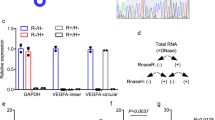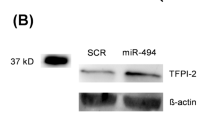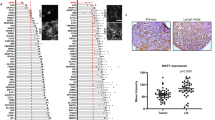Abstract
In a breast tumor xenograft model, the MCT-1 oncogene increases the in vivo tumorgenicity of MCF7 cells by promoting angiogenesis and inhibiting apoptosis. Increases in the tumor microvascular density are accompanied by a strong reduction in the levels of the angiogenesis inhibitor thrombospondin-1 (TSP1), but the mechanisms underlying this process are unknown. We show that TSP1 expression is controlled, at least in part, by post-transcriptional events. Using RNA interference to knock down the expression of the RNA-binding protein HuR in MCF7 cells as well as HuR overexpression, we demonstrate that HuR plays an important role in translation of the TSP1 mRNA. Furthermore, employing the RIP-Chip assay yielded 595 transcripts with significantly altered binding to HuR in the more tumorigenic breast cancer clones compared with the weakly tumorigenic clones. These mRNAs clustered in several pathways implicated in the transformed phenotype, such as the RAS pathway (involved in mitogenesis), the PI3K pathway (evasion of apoptosis) and pathways mediating angiogenesis and the cellular response to hypoxia. These findings demonstrate for the first time that global changes in HuR-bound mRNAs are implicated in the evolution to a more tumorigenic phenotype in an in vivo tumor model and underscore the role of global mRNA-protein interactions toward tumor progression.
This is a preview of subscription content, access via your institution
Access options
Subscribe to this journal
Receive 50 print issues and online access
$259.00 per year
only $5.18 per issue
Buy this article
- Purchase on Springer Link
- Instant access to full article PDF
Prices may be subject to local taxes which are calculated during checkout






Similar content being viewed by others
References
Abdelmohsen K, Pullmann Jr R, Lal A, Kim HH, Galbán S, Yang X et al. (2007). Phosphorylation of HuR by Chk2 regulates SIRT1 expression. Mol Cell 23: 543–557.
Aghib DF, Bishop JM, Ottolenghi S, Guerrasio A, Serra A, Saglio G . (1990). A 3′ truncation of MYC caused by chromosomal translocation in a human T-cell leukemia increases mRNA stability. Oncogene 5: 707–711.
Akool el-S, Kleinert H, Hamada FM, Abdelwahab MH, Forstermann U, Pfeilschifter J et al. (2003). Nitric oxide increases the decay of matrix metalloproteinase 9 mRNA by inhibiting the expression of mRNA-stabilizing factor HuR. Mol Cell Biol 23: 4901–4916.
Bevilacqua A, Ceriani MC, Capaccioli S, Nicolin A . (2003). Post-transcriptional regulation of gene expression by degradation of messenger RNAs. J Cell Physiol 195: 356–372.
Bhattacharyya SN, Habermacher R, Martine U, Closs EI, Filipowicz W . (2006). Relief of microRNA-mediated translational repression in human cells subjected to stress. Cell 125: 1111–1124.
Brennan CM, Steitz JA . (2001). HuR and mRNA stability. Cell Mol Life Sci 58: 266–277.
Calvano SE, Xiao W, Richards DR, Felciano RM, Baker HV, Cho RJ et al. (2005). Inflamm and Host Response to Injury Large Scale Collab. Res. Program. A network-based analysis of systemic inflammation in humans. Nature 437: 1032–1037.
Cheadle C, Vawter MP, Freed WJ, Becker KG . (2003). Analysis of microarray data using Z score transformation. J Mol Diagn 5: 73–81.
Galbán S, Kuwano Y, Pullmann Jr R, Martindale JL, Kim HH, Lal A et al (2008). RNA-binding proteins HuR and PTB promote the translation of hypoxia-inducible factor 1α. Mol Cell Biol 28: 93–107.
Galbán S, Martindale JL, Mazan-Mamczarz K, Lopez de Silanes I, Fan J, Wang W et al. (2003). Influence of the RNA-binding ;protein HuR in pVHL-regulated p53 expression in renal carcinoma cells. Mol Cell Biol 23: 7083–7095.
Gorospe M . (2003). HuR in the mammalian genotoxic response: post-transcriptional multitasking. Cell Cycle 2: 412–414.
Hanahan D, Weinberg RA . (2000). The hallmarks of cancer. Cell 100: 57–70.
Hollis GF, Gazdar AF, Bertness V, Kirsch IR . (1988). Complex translocation disrupts c-myc regulation in a human plasma cell myeloma. Mol Cell Biol 8: 124–129.
Katsanou V, Papadaki O, Milatos S, Blackshear PJ, Anderson P, Kollias G et al. (2005). HuR as a negative posttranscriptional modulator in inflammation. Mol Cell 19: 777–789.
Kawai T, Lal A, Yang X, Galbán S, Mazan-Mamczarz K, Gorospe M . (2006). Translational control of cytochrome c by RNA-binding proteins TIA-1 and HuR. Mol Cell Biol 26: 3295–3307.
Keene JD . (2001). Ribonucleoprotein infrastructure regulating the flow of genetic information between the genome and the proteome. Proc Natl Acad Sci USA 98: 7018–7024.
Keene JD . (2007). RNA regulons: coordination of post-transcriptional events. Nat Rev Genet 8: 533–543.
Keene JD, Komisarow JM, Friedersdorf MB . (2006). RIP-Chip: the isolation and identification of mRNAs, microRNAs and protein components of ribonucleoprotein complexes from cell extracts. Nat Protoc 1: 302–307.
Keene JD, Tenenbaum SA . (2002). Eukaryotic mRNPs may represent posttranscriptional operons. Mol Cell 9: 1161–1167.
Kim HS, Kuwano Y, Zhan M, Pullmann Jr R, Mazan-Mamczarz K, Li H et al. (2007). Elucidation of a C-rich signature motif in target mRNAs of RNA-binding protein TIAR. Mol Cell Biol 27: 6806–6817.
Kullmann M, Gopfert U, Siewe B, Hengst L . (2002). ELAV/Hu proteins inhibit p27 translation via an IRES element in the p27 5UTR. Genes Dev 16: 3087–3099.
Lal A, Abdelmohsen K, Pullmann R, Kawai T, Galbán S, Yang X et al. (2006). Posttranscriptional derepression of GADD45alpha by genotoxic stress. Mol Cell 22: 117–128.
Lal A, Kawai T, Yang X, Mazan-Mamczarz K, Gorospe M . (2005). Anti-apoptotic function of RNA-binding HuR effected through prothymosin α. EMBO J 24: 1852–1862.
Lal A, Mazan-Mamczarz K, Kawai T, Yang X, Martindale JL, Gorospe M . (2004). Concurrent versus individual binding of HuR and AUF1/HRNDP to common labile target mRNAs. EMBO J 23: 3092–3102.
Leandersson K, Riesbeck K, Andersson T . (2006). Wnt-5a mRNA translation is suppressed by the Elav-like protein HuR in human breast epithelial cells. Nucleic Acids Res 34: 3988–3999.
Levenson AS, Thurn KE, Simons LA, Veliceasa D, Jarrett J, Osipo C et al. (2005). MCT-1 oncogene contributes to increased in vivo tumorigenicity of MCF7 cells by promotion of angiogenesis and inhibition of apoptosis. Cancer Res 65: 10651–10656.
Levy NS, Chung S, Furneaux H, Levy AP . (1998). Hypoxic stabilization of vascular endothelial growth factor mRNA by the RNA-binding protein HuR. Biol Chem 273: 6417–6423.
Liao B, Hu Y, Brewer G . (2007). Competitive binding of AUF1/HRNDP and TIAR to MYC mRNA controls its translation. Nat Struct Mol Biol 14: 511–518.
Lopez de Silanes I, Fan J, Galban CJ, Spencer RG, Becker KG, Gorospe M . (2004). Global analysis of HuR-regulated gene expression in colon cancer systems of reducing complexity. Gene Expr 12: 49–59.
Lopez de Silanes I, Lal A, Gorospe M . (2005). HuR: post-transcriptional paths to malignancy. RNA Biol 2: 11–13.
Mazan-Mamczarz K, Galbán S, Lopez de Silanes I, Martindale JL, Atasoy U, Keene JD et al. (2003). RNA-binding protein HuR enhances p53 translation in response to ultraviolet light irradiation. Proc Natl Acad Sci USA 100: 8354–8359.
Mazan-Mamczarz K, Lal A, Martindale JL, Kawai T, Gorospe M . (2006). Translational repression by RNA-binding protein TIAR. Mol Cell Biol 26: 2716–2727.
Meijlink F, Curran T, Miller AD, Verma IM . (1985). Removal of a 67-base-pair sequence in the noncoding region of protooncogene fos converts it to a transforming gene. Proc Natl Acad Sci USA 82: 4987–4991.
Meng Z, King PH, Nabors LB, Jackson NL, Chen CY, Emanuel PD et al. (2005). The ELAV RNA-stability factor HuR binds the 5′-untranslated region of the human IGF-IR transcript and differentially represses cap-dependent and IRES-mediated translation. Nucleic Acids Res 33: 2962–2979.
Millard SS, Vidal A, Markus M, Koff A . (2000). AU-richelement in the 50 untranslated region is necessary for the translation of p27 mRNA. Mol Cell Biol 20: 5947–5959.
Nabors LB, Gillespie GY, Harkins L, King PH . (2001). HuR, a RNA stability factor, is expressed in malignant brain tumors and binds to adenine- and uridine-rich elements within the 3′ untranslated regions of cytokine and angiogenic factor mRNAs. Cancer Res 61: 2154–2161.
Orphanides G, Reinberg D . (2002). A unified theory of gene expression. Cell 108: 439–451.
Piecyk M, Wax S, Beck AR, Kedersha N, Gupta M, Maritim B et al. (2000). TIA-1 is a translational silencer that selectively regulates the expression of TNF-alpha. EMBO J 19: 4154–4163.
Prosniak M, Dierov J, Okami K, Tilton B, Jameson B, Sawaya BE et al. (1998). A novel candidate oncogene, MCT-1, is involved in cell cycle progression. Cancer Res 58: 4233–4237.
Pullmann Jr R, Kim HH, Abdelmohsen K, Lal A, Martindale JL, Yang X et al. (2007). Analysis of turnover and translation regulatory RNA-binding protein expression through binding to cognate mRNAs. Mol Cell Biol 27: 6265–6278.
Ren B, Yee KO, Lawler J, Khosravi-Far R . (2006). Regulation of tumor angiogenesis by thrombospondin-1. Biochim Biophys Acta 1765: 178–188.
Sheflin LG, Zou AP, Spaulding SW . (2004). Androgens regulate the binding of endogenous HuR to the AU-rich 3′UTRs of HIF-1alpha and EGF mRNA. Biochem Biophys Res Commun 322: 644–651.
Tenenbaum SA, Carson CC, Lager PJ, Keene JD . (2000). Identifying mRNA subsets in messenger ribonucleoprotein complexes by using cDNA arrays. Proc Natl Acad Sci USA 97: 14085–14090.
Wang W, Caldwell MC, Lin S, Furneaux H, Gorospe M . (2000a). HuR regulates cyclin A and cyclin B1 mRNA stability during cell proliferation. EMBO J 19: 1–12.
Wang W, Furneaux H, Cheng H, Caldwell MC, Hutter D, Liu Y et al. (2000b). HuR regulates p21 mRNA stabilization by UV light. Mol Cell Biol 20: 760–769.
Watnick RS, Cheng YN, Rangarajan A, Ince TA, Weinberg RA . (2003). Ras modulates Myc activity to repress thrombospondin-1 expression and increase tumor angiogenesis. Cancer Cell 3: 219–231.
Weidner N . (1998). Tumoural vascularity as a prognostic factor in cancer patients: the evidence continues to grow. J Pathol 184: 119–122.
Wilusz CJ, Wilusz J . (2004). Bringing the role of mRNA decay in the control of gene expression into focus. Trends Genet 20: 491–497.
Zabrenetzky V, Harris CC, Steeg PS, Roberts DD . (1994). Expression of the extracellular matrix molecule thrombospondin inversely correlates with malignant progression in melanoma, lung and breast carcinoma cell lines. Int J Cancer 59: 191–195.
Acknowledgements
We thank Dr Y Zhang for assistance with the statistical analysis of the RIP-Chip array data and Dr J Hasday for technical support. A Merit Review Award from the Department of Veterans Affairs to RBG supported this work. MG and SS were supported by the National Institute on Aging Intramural Research Program, NIH.
Author information
Authors and Affiliations
Corresponding author
Additional information
Supplementary Information accompanies the paper on the Oncogene website (http://www.nature.com/onc)
Supplementary information
Rights and permissions
About this article
Cite this article
Mazan-Mamczarz, K., Hagner, P., Corl, S. et al. Post-transcriptional gene regulation by HuR promotes a more tumorigenic phenotype. Oncogene 27, 6151–6163 (2008). https://doi.org/10.1038/onc.2008.215
Received:
Revised:
Accepted:
Published:
Issue Date:
DOI: https://doi.org/10.1038/onc.2008.215
Keywords
This article is cited by
-
CircEIF3H-IGF2BP2-HuR scaffold complex promotes TNBC progression via stabilizing HSPD1/RBM8A/G3BP1 mRNA
Cell Death Discovery (2022)
-
Oncogenic MCT-1 activation promotes YY1-EGFR-MnSOD signaling and tumor progression
Oncogenesis (2017)
-
Hepatitis C virus upregulates B-cell receptor signaling: a novel mechanism for HCV-associated B-cell lymphoproliferative disorders
Oncogene (2016)
-
Differential protein occupancy profiling of the mRNA transcriptome
Genome Biology (2014)
-
AngiotensinII induces HuR shuttling by post-transcriptional regulated CyclinD1 in human mesangial cells
Molecular Biology Reports (2014)



